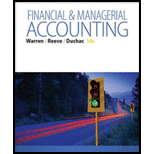
Concept explainers
Cash payback method:
Cash payback period is the expected time period which is required to recover the cost of investment. It is one of the capital investment method used by the management to evaluate the long-term investment (fixed assets) of the business.
In simple, the cash payback period is computed as follows:
Average
Average rate of return is the amount of income which is earned over the life of the investment. It is used to measure the average income as a percent of the average investment of the business, and it is also known as the accounting rate of return.
The average rate of return is computed as follows:
To explain: Whether a one-year payback period is same as a 100% average rate of return.
Want to see the full answer?
Check out a sample textbook solution
Chapter 25 Solutions
Financial & Managerial Accounting
- Calculate the return on assets, profit margin, assets turnover ratio?arrow_forwardPrimeGear has fixed costs of 2,880,000 and variable costs per unit of 185 during a trading year. It is sold to wholesalers at 250 per unit. Calculate: (i) the number of units that must be sold in order to break even. (ii) the level of output required to provide a profit of 520,000.arrow_forwardHelp this answerarrow_forward
- I want the correct answer with general accountingarrow_forwardDuring the year, Lexor Accessories sold 950,000 travel wallets under a new promotional program. Each wallet included a coupon offering a $6.00 cash rebate. Lexor estimates that 80% of the coupons will be redeemed, although only 480,000 coupons had been processed by year-end. At December 31, how much liability should Lexor report for unredeemed coupons? A. $1,296,000 B. $2,280,000 C. $1,680,000 D. $3,060,000 MCQarrow_forwardRadiant Co. has a target of earning $85,000 pre-tax income. The contribution margin ratio is 40%. What amount of dollar sales must be achieved to reach the goal if fixed costs are $55,000? a. $140,000 b. $212,500 c. $250,000 d. $312,500 e. $350,000arrow_forward
 Managerial AccountingAccountingISBN:9781337912020Author:Carl Warren, Ph.d. Cma William B. TaylerPublisher:South-Western College Pub
Managerial AccountingAccountingISBN:9781337912020Author:Carl Warren, Ph.d. Cma William B. TaylerPublisher:South-Western College Pub
